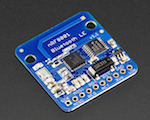| Info | ||
|---|---|---|
| ||
|
...
Since transactions are asynchronous, it is possible to send a command while receiving incoming data or a response to a previous command. The application could handle this by always transferring a maximum (32-byte) SPI buffer for each master transaction, but the mote SPI bus allows for more flexibility than that. Rather than using one of the built-in slave-select lines, the application uses an output line (S_MOSI) to stop the SPI transfer after receiving the incoming header. It decides which packet (incoming or outgoing) is longer, and only clocks out the needed bytes to send in each direction.
Hardware Connection
| LTC5800 pin | Direction (from LTC5800) | nrf8001 pin | Notes |
|---|---|---|---|
M_SCK | OUT (SPI) | SCK | SPI Master clock |
M_MISO | IN (SPI) | MISO | SPI Master input |
M_MOSI | OUT (SPI) | MOSI | SPI Master output |
S_MOSI | OUT | REQn | Used in place of slave select (active low) |
DP2 | IN | RDYn | Signals that the nrf8001 is ready to transfer asynchronous data (active low) |
NC | ACT | No connect | |
PWM0 | OUT | RSTn | nrf8001 reset (active low) |
NC | 3Vo | No connect | |
GND | GND | Ground | |
VSUPPLY | VIN | 3.6 volts |
Mote CLI commands
The sample app adds two CLI commands to the basic set provided by the stack:
send -once connected, this command allows you to send text strings (<= 20 bytes) to the iOS Connect application. It prints an error if there is no BLE connectionreset -resets the mote (and the nrf8001 chip)
Running the Demo
Connect to the mote CLI (9600 baud, 8 data bits, 1 stop bit, no parity) to view mote prints.
...
